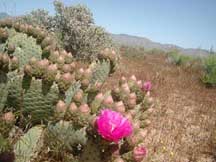Naso: Transforming The Desert
A G-dless Environment
The Temple service, described in our Parsha, was held in an arid and barren locale, the desert. G-d charged our ancestors with a special mission: transform the desert and make it bloom, bloom with the flowering blossoms of spirituality. In our day we have a similar mission: transform your inner desert and make it bloom.
We work hard to fill our lives with Torah and divine meaning. Though we enjoy a relative degree of success we each have a “desert”dimension within, that we have yet to transform.
The Spiritual Desert
The desert is described in the Torah as a place that is “Lo Yashav Adam Sham” – “uninhabited by man” (Jeremiah 2, 6). The Hebrew word for man, “Adam,” is translated by our sages as “Adameh Lielyon” – similar to the supernal one (G-d).
In this sense the desert is a place, or a dimension within man, that is uninhabited, or uninfluenced, by the, supernal one i.e. G-d. It falls to us to transform our personal desert.
Two Strains of Worship
This is where we borrow a page from our past and apply it to our present. There were two families in the tribe of Levi who were responsible for the transportation of the tabernacle across the desert.
These families divided the duties equally. One transported the walls and covers of the tabernacle, the other transported the sacred vessels, such as the Holy Ark. In the context of our discussion, the walls and covers are the protectors; the vessels are the protected.
In our lives we have similar strains of worship.
One is “Sur Mera”- to refrain from that which is improper, the second is “Aseh Tov” – to engage in that which is proper. Refraining from the improper acts as a protecting cloak around our soul similar to the walls and covers of the tabernacle.
Engaging in that which is proper comprises the soul itself, our personal house of G-d. Every Mitzvah represents an aspect of this holy house analogous to the actual vessels that comprised the sanctity of the tabernacle. The transport of these elements symbolizes the spiritual notion of carrying these efforts forward, thus transforming our “desert” dimension.
Gershon and Kehat
We now understand the names of the two Levitic families engaged in this labor of transportation.
The family that carried the walls and covers was named Gershon, in Hebrew this translates as “banish.” This refers to the work of “banishing” our wicked and our selfish tendencies as per our matriarch Sarah’s instructions, “Garesh Et Ha’amah Hazot V’et Bnah” – “Banish the slave-woman and her son” (Genesis 21, 10). The “slave-woman” is the animal soul within us, the source of wicked tendencies. The “son” refers to those tendencies themselves.
The family that carried the Holy Ark was named Kehat. The root of this word in Hebrew is “Yikhat” (Geneis 49, 10) which means, to gather the dispersed and form a single block. This refers to the work of collecting as many Mitzvot as we can, to form a single block of merit that will propel us onward in our service to G-d.
Conclusion
May we all merit to transform our personal deserts into blooming orchards overflowing with the fruits of our labor. May the fragrance and beauty of our orchards inspire others to undertake similar efforts. May we initiate a cycle that will “carry us forward” into a new era of peace and prosperity. Amen!
Tags: desert, discipline, introspection, transformation


























